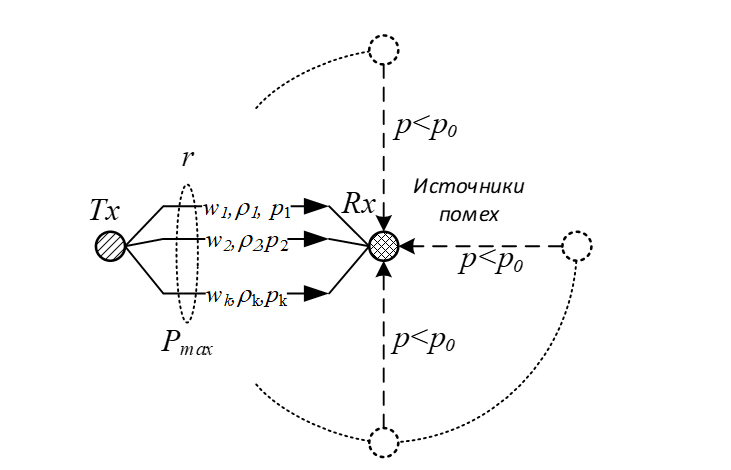
Transmission Power Distributing Method for the Internet of Things Heterogeneous Networks
https://doi.org/10.31854/1813-324X-2025-11-4-97-105
EDN: QVTBIX
Abstract
Relevance. The development of the Internet of Things networks, being one of the priority areas of telecommunications development, leads to the formation of networks with a high concentration of devices - high-density and ultra-high-density networks. To ensure the functioning of such networks, various communication technologies can be used, which leads to the formation of heterogeneous networks of the Internet of Things. These can be data collection networks, machine-to-machine (M2M) communication networks, telecontrol and others. The use of many technologies requires the application of methods that ensure the efficiency of their use for data transmission. In this paper, one of such methods is proposed that ensures an increase in the efficiency of a heterogeneous Internet of Things network.
Problem statement. Development of a model and method for distributing power between subchannels in nodes of a heterogeneous high-density Internet of Things network, taking into account the features of such networks, allowing to obtain a description of their functioning and ensure an increase in the efficiency of functioning due to the redistribution of transmission power across subchannels.
Purpose of the work. Improving the efficiency of a heterogeneous high-density Internet of Things network. To solve the problem, methods of mathematical modeling, information theory, optimization and numerical modeling were used.
Result. A modeling and methodological apparatus has been developed that ensures increased efficiency of a high-density heterogeneous Internet of Things network due to optimal power redistribution between data transmission subchannels, which makes it possible to increase the data transmission rate at a fixed transmission power.
Novelty. The efficiency of the proposed method is ensured by solving the problem of optimal power distribution between subchannels taking into account the amount of interference and the serviced traffic (usage). The efficiency of the method depends on the parameters of the subchannels. It is minimal for identical subchannels and increases with increasing differences between the parameters of the subchannels used. The proposed method takes into account the traffic transmitted via subchannels (subchannel load) and their features in terms of achievable transmission speed, which makes it possible to adapt this method to specific conditions.
Practical significance. The developed model and method can be used in the construction of devices and heterogeneous networks of the Internet of Things of high density in order to increase their efficiency. The method of power distribution by subchannels can be used in the implementation of the transmission control system (protocol) for devices using various technologies for organizing transmission channels.
About the Authors
F. N. HuangRussian Federation
A. I. Paramonov
Russian Federation
References
1. Rec. ITU-E Y.2060 (12/2012). Requirements for supporting machine-oriented communication applications in a next-generation network environment. (in Russ.)
2. Koucheryavy A., Paramonov A., Makolkina A., Muthanna A.S.A., Vybornova A., Dunaytsev R. et al. 3 Dimension Multilayer Heterogenous Ultra Dense Networks. Telecom IT. 2022;10(3):1‒12. (in Russ.) DOI:10.31854/2307-1303-2021-10-3-1-12. EDN:LHLYEM
3. Selvaraju S.P., Balador A., Fotouhi H., Vahabi M., Bjorkman M. Network Management in Heterogeneous IoT Networks. Proceedings of the International Wireless Communications and Mobile Computing, IWCMC, 28 June ‒ 02 July 2021, Harbin City, China. IEEE; 2021. p.1581‒1586. DOI:10.1109/IWCMC51323.2021.9498801
4. Mshvidobadze T. Heterogeneous IoT Platform in Network Architecture. International Journal of Computers. 2022;16:60‒65. DOI:10.46300/9108.2022.16.12
5. Koucheryavy A., Okuneva D., Paramonov A., Hoang N. Methods of Traffic Distribution in a Heterogeneous High-Density Internet of Things Network. Proceedings of Telecommunication Universities. 2024;10(2):67‒74. (in Russ.) DOI:10.31854/1813-324X-2024-10-2-67-74. EDN:RTNVEU
6. Buziukov L., Okuneva D., Paramonov A. Problems of Building Wireless Sensor Networks. Proceedings of Telecommunication Universities. 2017;3(1):5‒12. (in Russ.) EDN:YMHZIX
7. Tonkikh E.V., Paramonov A.I., Koucheryavy A.E. Analysis of Wireless High-Density IoT Network. Elektrosvyaz'. 2020;1:44‒48. (in Russ.) DOI:10.34832/ELSV.2020.2.1.006. EDN:IWAHZO
8. Shennon K. Works on Information Theory and Cybernetics. Translated from English. Moscow: Izdatel'stvo inostrannoj literatury Publ.; 1963. 829 p. (in Russ.)
9. Zyuko A.G., Klovsky D.D., Korzhik V.I., Nazarov M.V. Theory of Electrical Communication. Moscow: Radio i svyaz' Publ.; 1999. 432 p. (in Russ.)
10. Panteleev A.P., Letova T.A. Optimization Methods in Examples and Problems. Moscow: Vysshaya shkola Publ.; 2005. 544 p. (in Russ.)
11. Qi Q., Minturn A., Yang Y. An efficient water-filling algorithm for power allocation in OFDM-based cognitive radio systems. Proceedings of the International Conference on Systems and Informatics, ICSAI2012, 19‒20 May 2012, Yantai, China. IEEE; 2012. p.2069‒2073 DOI:10.1109/ICSAI.2012.6223460
12. Boyd S.P., Vandenberghe L. Convex Optimization. Cambridge University Press, 2004. 716 p.
13. Gallager R. Information Theory and Secure Communications. Moscow: Sovetskoe radio Publ.; 1974. 720 p. (in Russ.)
14. Nir V. L., Scheers B. Distributed Power Allocation for Parallel Broadcast Channels with Only Common Information in Cognitive Tactical Radio Networks. EURASIP Journal on Wireless Communications and Networking. 2010:172013. DOI:10.1155/2010/172013
Review
For citations:
Huang F.N., Paramonov A.I. Transmission Power Distributing Method for the Internet of Things Heterogeneous Networks. Proceedings of Telecommunication Universities. 2025;11(4):97-105. (In Russ.) https://doi.org/10.31854/1813-324X-2025-11-4-97-105. EDN: QVTBIX


































